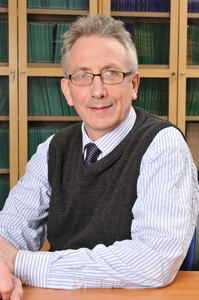Sir Simon Donaldson is a permanent member of the Simons Center for Geometry and Physics at Stony Brook University. He received his B.A. in Mathematics from Pembroke College of Cambridge University in 1979 and his Ph.D. from Oxford University in 1983, studying first under the supervision of Dr. Nigel Hitchin and later under Sir Michael Atiyah. His thesis was The Yang-Mills Equations on Kähler Manifolds, written in 1983, where he showed the equivalence of anti-self-dual connections and stable holomorphic structures on bundles over algebraic surfaces. Donaldson’s most renowned work is his study of the topology of smooth (differentiable) four-dimensional manifolds. Among his most noted achievements are his proof of the diagonalizability theorem sometimes referred to as Donaldson’s theorem (proved when he was still a graduate student), and his algebraic invariants of four-manifolds codified into what are now called the Donaldson polynomial invariants. These results relied on his study of gauge theory of principal bundles over four-manifolds, a theory closely related to ones intensively studied by physicists. His more recent work includes the introduction of pencils of curves in a symplectic four-manifold and his study of extremal metrics, including Kahler-Einstein metrics on Fano varieties, and the relation of these to algebro-geometric stability. In 1986 he was awarded the Fields Medal for his work in the geometry and topology of 4-dimensional manifolds, and was elected a Fellow of the Royal Society. He was awarded the Crafoord Prize in Mathematics in 1994. He was elected a foreign member of the US National Academy of Sciences in 2000. In 2006 he was awarded the King Faisal International Prize for his work in mathematical theories linked to physics. In 2009, he was awarded the Shaw Prize in Mathematical Sciences for his work in conjunction with Taubes “for their many contributions to geometry in three and four dimensions”. In 2010 he was elected a foreign member of the Royal Swedish Academy of Sciences. In 2012 he was elected a Fellow of the American Mathematical Society and was knighted for his services to Mathematics.


